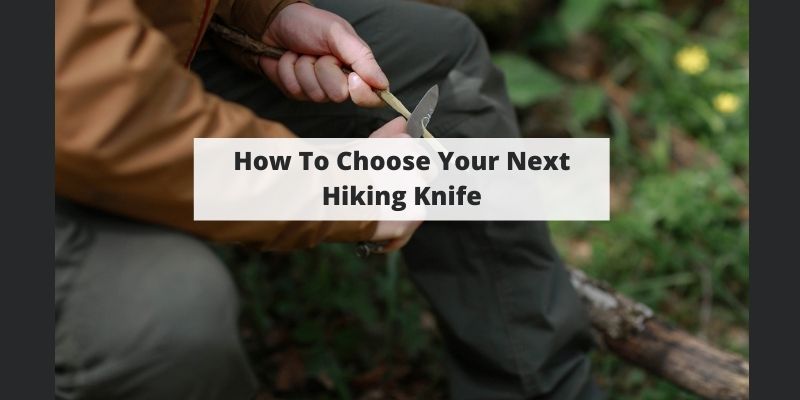Hiking is one of the best outdoor activities for health and adventure. However, the natural environment is a place with many dangers. Carrying a hiking knife is one of those highly recommended items. Knives are defense weapons, survival weapons, and general utility tools. When hiking, you want a compact, sturdy, durable, and easy to use knife. Choosing a best knife for hiking is intricate and requires keen consideration; because your life may depend on it. Here’s what you should consider, as well as some of our top recommended picks.
What Hikers Should Consider When Choosing a Knife for Hiking
Folding Knife or Fixed Blade Knife
Though it may seem obvious that folding blades are more convenient to carry and use, fixed blades may be a better option. Fixed blades are designed to withstand a great deal of pressure due to a lack of moving parts. They have longer durability since there is no wear and tear due to friction. They are easy to use and quickly accessible in an emergency. The possibility of an accident is also low since there are no moving parts. Folding knives, on the other hand, are at the risk of breaking at the holding point due to lateral forces. They are difficult to maintain and access and could easily cause accidents if mishandled. However, folding knives are more compact, convenient for carrying around. They do not need a sheath, and most are multipurpose; you may get more tools alongside the knife. Fixed knives are potentially a better option when in a survival situation, but folding tactical knives have a compactability and simplicity advantage.
Blade Material for Top Hiking Knives
Blade material is another very important factor to consider when selecting your hiking knife. The material must be high quality and strong for any activity such as curving, chopping, hunting and even self- defense. It should be able to sustain sharpness for long periods of time and be rust resistant, in case the conditions are humid.
For example, cheap normal steel is an unreliable material for a blade. It is easy to sharpen but also easy to break. It also blunts quickly, making it inefficient in many settings. Alloys are often a good start since they are stronger and more durable than pure metals.
Stainless steel is the most common material for knife blades. Enough chromium in its content gives it great resistance to rust, strength and durability. Titanium, another good option, is a strong metal, rust-resistant, hard, and amazingly light. Some of the latest quality materials for blades include S30V, a blend of Vanadium and stainless steel. VG10 (stainless), 154CM AND 420HC are also quality blends of carbon and stainless steel, D2, 01 and High carbon steel.
The Blade Edge
The edge of the blade should be easy to sharpen and sustain sharpness. The material of the blade should also be strong to avoid the edges chipping off during use. The blade edge may be plain, serrated or combo.
Plain/Flat Edge: The smooth edge makes it easy to handle, clean and sharpen. Its continuous edge makes it more versatile than any other type. It is used for clean push cuts on soft materials such as slicing cheese, skinning and cutting meat, cutting a cord. It is the most common type used for hunting and hiking. It, however, does not maintain sharpness for long like serrated edges. It is also difficult to use a flat- edged knife to saw through a tough item such as a rope or firewood. If the hike is less likely to require these activities, then a plain knife is the best choice.
Partially Serrated/Combo: This features serration near the handle to give you a sturdy grip, and then the blade becomes flat towards the tip. When you cannot decide what to take, a combo is the best solution. It combines the excellent rope-cutting and sawing features of a serrated edge and the smooth push cutting characteristics of a plain edged knife.
The combined advantages of the two types of edges are highly appreciated by many hikers since its applications are all round. Hence it is double efficient. However, there are setbacks to the combo.
Sharpening can prove quite difficult. You may be able to get the plain part sharp, but the serrated part mostly required professional sharpening to get it back to factory sharpness. You will also lose the length advantage for both knives. If combo works well for you, then it is a good option.
Blade Tip and Shape for Hiking
The tip of the blade varies depending on the use of the knife. Despite the blade shape, the tip must be sharp. It is unimaginable to survive in the wilderness without a tipped blade. Every activity including cooking, digging up and skinning game needs that sharp edge. Some of the most common blade shapes for hiking knives are:
1. Drop-Point: This is multipurpose blade shape general efficiency and sturdiness. It is great for outdoor survival. It has sharp, smooth cutting edges for skinning. However, its tip is not great for piercing.
2. Clip-Point: The back edge runs smoothly up the blade, and then curves slightly towards the tip. The other edge is usually serrated. It is excellent for piercing and hunting. However, the point is thin and weak.
3. Spear-Point: Is a double-edged symmetric blade with spear-like properties hence a great throwing or stabbing knife. The tip is strong, and recession of the edges is for good piercing. However, the edges for smooth slicing are absent.
Handle Material
The handle of your knife is imperative since when handling the hiking knife, you need to be comfortable and have a firm grip. The wrong handle could cause mistakes, injury or even fatal situations. Common handle materials for a best knife for hiking;
• Wood: They are traditionally strong and attractive but susceptible to destruction by moisture.
• Metal: Most metals used are Aluminum, Stainless steel and titanium. Aluminum is solidly strong and lightweight, but quickly absorbs and loses heat. Stainless Steel is also strong and corrosion resistant, but heavier than other metals. Titanium is lighter and retains less cold than Aluminum.
• Bones: This bizarre ancient material gives a surprisingly strong grip and physical beauty.
• Plastic: It has a natural grip and popular for hiking knives. It is best used as an alloy of plastic and stainless steel.
• Glass-Reinforced Nylon: It is a cheap, durable material that is malleable and comes in different textures. It can withstand very harsh conditions hence little maintenance required.
Weight
The weight of a knife is an important feature to watch out for, even for short-distance hiking. The recommended interval is about 23 g minimum up to 660g maximum. Take a look at what you need your knife for. You can approximate the weight required to accomplish your tasks. Unless you plan to perform heavy duty tasks such as firewood collection, a knife less than 2 ounces will be enough. The problem with heavy knives is that they slow you down, and it is difficult to get small things done. Carry as light a knife as possible and even choose a lightweight blade and handle materials, so you feel comfortable when trekking.
Sheath
The sheath affects the portability and handling of your knife. There are different sheaths you can attach to various parts of your body. First of all, a strap should importantly cross over to the knife handle to prevent the knife from falling out. Low attachment sheath allows you to strap the knife to your belt of the leg. The sheath may even have a belt loop. Some knives, such as the folding knife, do not require a sheath.
Knife Warranty
Most warranties are limited for lifetime and require proof of purchase or a copy of the original certificate of authenticity. In the case your knife is defective, report to the company and do not use or disassemble it. However, it is important to keep the knife in good condition and in its sheath when not in use.
Final Verdict
Hiking knives are very popular today, and their quality and features are growing significantly. As a hiker, you definitely need a knife as a tool for survival and self-defense. The various factors to consider when choosing a knife are the blade material, shape, edges, handle material, weight, sheath and warranty. If the knife of your choice has all these factors right, then it is the knife is probably the best choice for your needs.
Recommended Best Knives for Hiking
CRKT Homefront Aluminum Folding Pocket Knife
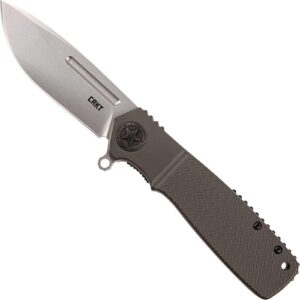
Best Features:
- Compact and Lightweight Design
- Easy Disassembly
- Steel Drop Point Blade
Gerber Highbrow or Highbrow Compact Knife
The Gerber Highbrow is a heavier duty knife great for day hikes, backcountry camping, or everyday use. The safety keeps it locked away when not needed, but the Finger Flipper assisted opening mechanism makes it so this knife can be pulled out with one hand in a matter of a second. This knife is easy to pull out, use, and put back all with one hand. It is extremely sturdy, and the wide grip gives it extra power and comfort when needed. If looking for a heavier duty, or a more compact version, this knife comes in a regular or compact size.
Best Features:
- Extremely durable
- Safety lock
- Easy one handed operation
See Highbrow On Gerber | See Highbrow Compact On Gerber | See On Amazon
Victorinox Swiss Army Hunter XT Knife
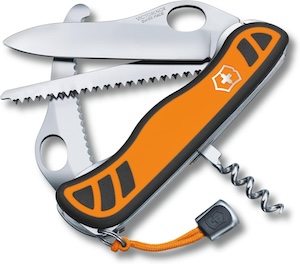
Best Features:
- Compact Design
- Multiple Useful Survival Tools
- Lifetime warranty
- Very lightweight
Spyderco Para Military 2
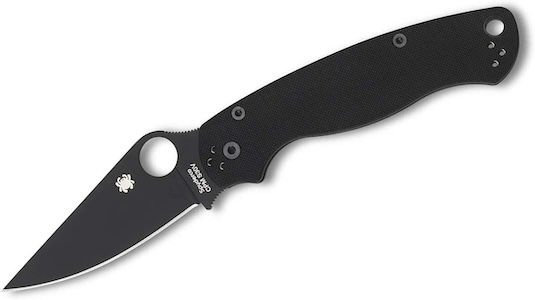
Best Features:
- Slip Resistent Handle
- CPMS30 V Steel Blade
- Plain edge or serrated edge
- Simple design with extreme durability and ease of use.
Gerber Bear Grylls Ultimate Pro Knife

Best Features:
- Extremely Study Design
- Fire Starter Attached
- Carbon Stainless Steel Drop Point Blade
- Rubber Handle
- Steel Pommel for Hammering
Morakniv Carbon Steel Fixed-Blade Bushcraft Survival Knife
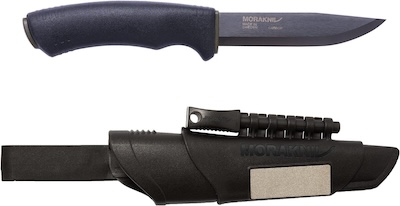
Best Features:
- Sturdy Design
- Fire Starter Attached
- Great Sheath
- Lifetime Warranty
SOG SEAL Pup Elite Fixed Blade E37S-K

Best Features:
- Sturdy Design
- Straight Edge & Serrated Edge
- Great Sheath
- Great Grip
Max DesMarais is the founder of hikingandfishing.com. He has a passion for the outdoors and making outdoor education and adventure more accessible. Max is a published author for various outdoor adventure, travel, and marketing websites. He is an experienced hiker, backpacker, fly fisherman, backcountry skier, trail runner, and spends his free time in the outdoors. These adventures allow him to test gear, learn new skills, and experience new places so that he can educate others. Max grew up hiking all around New Hampshire and New England. He became obsessed with the New Hampshire mountains, and the NH 48, where he guided hikes and trail runs in the White Mountains. Since moving out west, Max has continued climbed all of the Colorado 14ers, is always testing gear, learning skills, gaining experience, and building his endurance for outdoor sports. You can read more about his experience here: hikingandfishing/about

